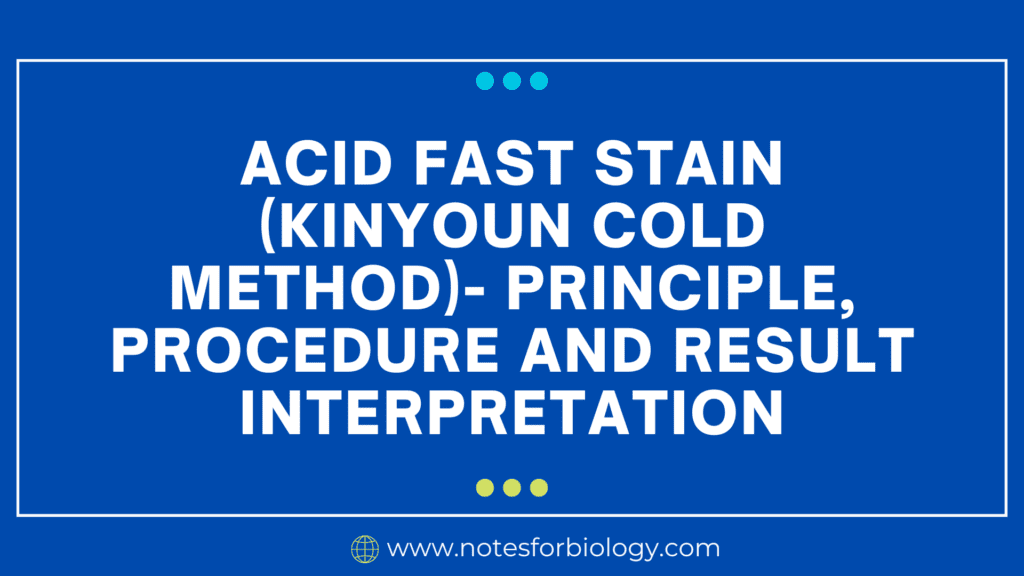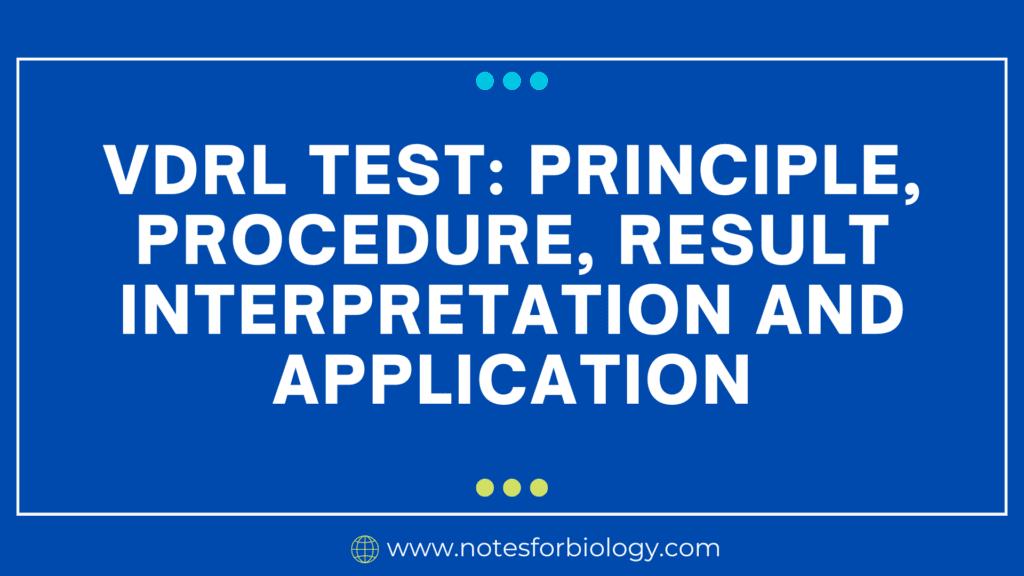The Kinyoun Cold Method is a modified version of the traditional Ziehl-Neelsen acid-fast stain technique used for identifying acid-fast bacteria, particularly Mycobacterium species such as those causing tuberculosis and leprosy. This method, developed by Joseph Kinyoun, does not require heating (“cold” method), making it simpler and safer for routine laboratory use. Here’s an overview of the Kinyoun cold method:
Table of Contents
Kinyoun Cold Method
Principle
The principle of kinyoun Cold Method is it is high lipid content (mycolic acids) in acid-fast organisms’ cell walls—which hold onto the main stain even after being decoloured with an acid-alcohol solution—is the basis for the Kinyoun Cold Method. Acid-fast mycobacteria are waxy and resistant to staining with aqueous-based stains like the Gram stain because they have mycolic acid in their outer membrane. To enable the principal stain, carbolfuchsin, to pierce the waxy exterior of acid-fast bacteria, phenol is added to the cells before the stain is applied. 1% sulfuric acid is used to treat the surplus stain. The cells are then stained with methylene blue, a secondary stain.
Materials
- Primary Stain:Carbol fuchsin
- Decolourizer: Acid-alcohol (a mixture of hydrochloric acid and ethanol)
- Counterstain: Methylene blue or brilliant green
Procedure
- Before staining, prepare and fix the specimen smear.
- At room temperature, cover the smear with carbolfuchsin for three to five minutes.
- Rinse the slide with water very gently.
- Apply a 1% sulfuric acid decolourizer to the slide and let it sit for about three minutes.
- Once the solution runs clear, rinse the slide with water and repeat the decolorization process for one to two minutes.
- Use water to rinse the slide.
- For one minute, cover the smear with methylene blue, the secondary or counterstain.
- Rinse the slide with water very gently.
- Using bibulous paper, blot the slide dry.
Result Interpretation
Acid-Fast Bacteria (AFB)
Appear red or pink due to retention of carbol fuchsin.
Non-Acid-Fast Cells
Appear blue or green, depending on the counterstain used.
Limitations of Kinyoun Cold Method
Sensitivity
The Kinyoun Cold Method may be less sensitive than the Ziehl-Neelsen method for detecting low numbers of acid-fast bacilli (AFB).
Staining Intensity
Kinyoun Cold Method is acid-fast organisms might not stain as intensely as with the Ziehl-Neelsen method, making them harder to identify under the microscope. This can be particularly challenging for less experienced technicians.
Decolorization Control
Kinyoun Cold Method is over-decolorization or under-decolorization can occur, affecting the differentiation between acid-fast and non-acid-fast organisms.
Technical Variability
Kinyoun Cold Method is variability in staining technique among different technicians can lead to inconsistent results. Training and standardization are necessary to minimize such variability.
Background Staining
It can sometimes result in high background staining, making it difficult to distinguish AFB from other cellular material and debris.
Interpretation Challenges
It can differentiate true acid-fast organisms from non-specific staining artifacts can be challenging, particularly in complex samples with mixed microbial populations.
Applications:
Tuberculosis (TB) Diagnosis
In clinical microbiology, the Kinyoun stain is widely used to identify Mycobacterium tuberculosis, the TB causative agent, in tissue biopsies, sputum samples, and other clinical specimens. It facilitates the prompt diagnosis and start of the right course of treatment.
Nontuberculous Mycobacteria (NTM) detection
Other Mycobacterium species that can cause infections are also found using this staining technique, particularly in patients with impaired immune systems. Mycobacterium avium complex (MAC) and Mycobacterium kansasii are two examples.
Identification of leprosy
The leprosy-causing bacteria, Mycobacterium leprae, can be identified using this approach from skin lesions and other pertinent clinical samples.
Acid-Fast Bacteria Identification in Environmental Samples
In environmental microbiology, the Kinyoun method is used to discover acid-fast bacteria in soil, water, and other environmental
It is a useful option in many laboratory settings because of its affordability, ease of use, and capacity to clearly visualize acid-fast organisms without the requirement for heating.
FAQ (Frequently Asked Questions):
What is Kinyoun Cold Method?
It is a modified version of the traditional Ziehl-Neelsen acid-fast stain technique used for identifying acid-fast bacteria, particularly Mycobacterium species such as those causing tuberculosis and leprosy.
State the principle of acid fast stain?
It is high lipid content (mycolic acids) in acid-fast organisms’ cell walls—which hold onto the main stain even after being decoloured with an acid-alcohol solution—is the basis for the Kinyoun Cold Method.
What are the applications of kinyoun Cold Method?
It is tuberculosis diagnosis, identification of leprosy ,non tuberculosis mycobacteria detection and so on.
What are the materials used in kinyoun Cold Method?
The materials used in kinyoun cold method are primary stain, decolorizer , counter stain.
Related Article




